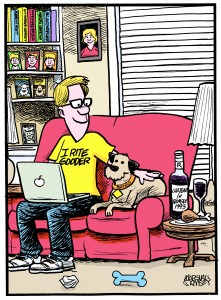 When I was about three, my mom (who is an art teacher) recognized I could draw. She showered me with what every budding artist needs: Paper, pencils and praise. When I was a eight, I fell in love with the editorial cartoons on the newspaper — and the comics, too. I just knew that the Peanuts’ gang were my best friends. I met WSB TV’s Bill Daniels (who later was the first graphic artist for the Weather Channel) and his imagination and cartoons lit a fire in my heart. Mad Magazine’s Jack Davis, Al Jaffee, Mort Drucker and Don Martin taught me about satire and art. The 1970’s were a time of great political turmoil and a heyday for editorial cartoons. The dye was cast. I knew what I wanted to do when I grew up.
When I was about three, my mom (who is an art teacher) recognized I could draw. She showered me with what every budding artist needs: Paper, pencils and praise. When I was a eight, I fell in love with the editorial cartoons on the newspaper — and the comics, too. I just knew that the Peanuts’ gang were my best friends. I met WSB TV’s Bill Daniels (who later was the first graphic artist for the Weather Channel) and his imagination and cartoons lit a fire in my heart. Mad Magazine’s Jack Davis, Al Jaffee, Mort Drucker and Don Martin taught me about satire and art. The 1970’s were a time of great political turmoil and a heyday for editorial cartoons. The dye was cast. I knew what I wanted to do when I grew up.
In 1985, my high school newspaper advisor tapped me to be Sprayberry High School’s student newspaper (The Stinger) cartoonist. My first cartoon, featuring the librarian in a Nazi helmet, didn’t get me the response I expected: Instead of rose petals tossed at my feet, I was sent straight to the principal’s office. But I explained how it was about how hard it was to get into the library. And it started a conversation that got that policy changed.
I was hooked.
In 1987, I began my career as a cartoonist for The Daily Beacon, the student newspaper for the University of Tennessee. I learned discipline, deadlines and how to deal with 13 different editors. For the next four years, my work graced the Beacon’s pages. I met Charlie Daniel, the long-time cartoonist at the Knoxville News-Sentinel. He allowed me to fill in for him and gave me a template for what I do. And he and his wife Patsy fed me, too.
My dream was set: I was going to be an editorial cartoonist.
I’ve had people doubt that dream. An advisor told me not to bother to try out for the Beacon because “they already had a cartoonist.” Other cartoonists claimed the profession was dying in the early 1990s (some may argue they were right). I’ve had people tell me that I was crazy because there were so few jobs. (There are more NBA basketball players than editorial cartoonists.) I’ve watched my industry struggle with change. I’ve seen dozens of amazing editorial cartoonists laid off. I worked as a janitor, advertising artist and a creative director before my dream came true.
But it did.
I’ve been blessed to be living that dream for nearly two decades.
Change has threatened it, though. I no longer do what I used to do every day. But that’s OK. Because what seemed like catastrophic change has done nothing but make me better at what I do. Like rocks in a swift stream, it polished me. And it opened up new doors for me. I discovered I could do things I never knew I could do before: I can write. Talk on the radio. Illustrate books. Speak before huge crowds. Take pictures of oak trees.
People ask me, “what do I do if MY dream dies?” I smile and say, “Wake up and dream another dream.” I know that sounds simplistic. But I’ve learned to embrace the change that has washed over me. And I can tell you this much, my life is much stronger for it. I’m always looking at what I’ll do next.
Thank you for reading my cartoons, books, posts. Thank you for listening to my radio show and speeches. And thank you for keeping an eight-year-old’s dream alive.

Marshall, I became acquainted with your work, when my twin granddaughters attended a reading of your Banjo book, in Vicksburg, MS. I really enjoy your cartoons, and have often wondered if you ever worked with Charlie Daniel of the Knoxville News Sentinel. I think your cartoons are similar to his, and I always loved his work! I always wished I had kept every cartoon insert, from the newspaper, that I got at UT Football games! I do have lots of them, as we use to attend many games (UTK Class of ’75)!
I googled you, and found out that you did work with Charlie! Keep up the good work!!!
Charlie is my mentor and friend. I never based my style on his, but I approach my job based on how he does his.